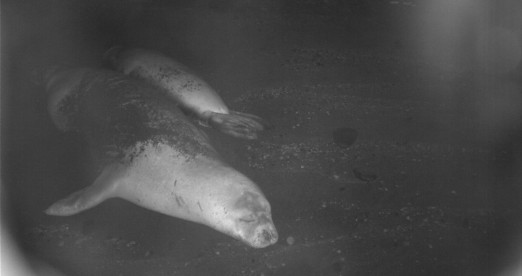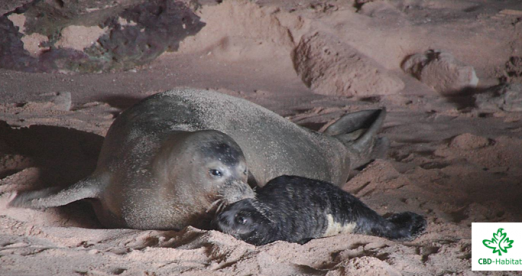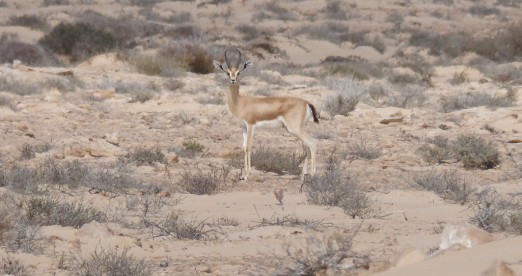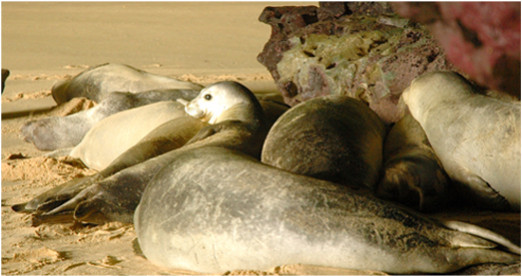Camera traps fot the monitoring of the Atlanctic monk seals population
Publicado por Fundación CBD-Habitat
At the post of May 25th, we told you how were the breeding caves of Cabo Blanco monitored, using surveillance cameras, with which a very precise, continuous and in real time monitoring of the colony is achieved. However this methodology can only be used at this place, where there are very particular morphological conditions of the caves and where there is the possibility of installing, above the cliffs, a room with monitors. At the rest of the distribution area of the species, the conditions are usually quite different and we have to look for other alternatives.
In our case, the story started when we had to determine the distribution of the seals at the north area of the breeding caves, a remote area of difficult access. The first step was to study the habitat and do an inventory of the most interesting caves. Afterwards we needed to find the best methodology to monitor those caves.
So that is how in 2008 we started to use camera traps. The first problem faced was that the lenses of the cameras got dirty and started to be useless not long after installation due to marine spray and sand dragged by the strong winds of the area. To solve it, we developed an automatic system that cleans the lens periodically.
On 2012, CBD-Habitat foundation and Nature park service of Madeira (in Portuguese SPNM) started to work together on the improvement of the camera trap system developed at Cabo Blanco to adapt it to the specific conditions of Madeira archipelago. This collaboration got a strong impulse on 2014 after the approval of the project LIFE 13 NAT/ES/000974 which its principal aim is to establish a surveillance system of the conservation status of the monk seal at the archipelago of Madeira. Here, the use of the camera trap system is looked as an essential tool to do the monitoring and control of the seals population and of its terrestrial habitat.
This years, methodology has improved notably. The electronic equipment was protected inside water-proof boxes, capable of tolerate immersions in marine water without damage. The use of no glow infrared was included, which allow us to see the animals inside pitch black caves, without disturbing them.
The actual autonomy of this equipment is of 10 months, on this period cameras take pictures on a regular interval of time (1 pic/hour), obtaining a regular sampling of the seals activity at the caves.
A few days ago we finished a campaign with the SPNM under the frame of the LIFE project.


Once again we are very happy with the results. The cameras installed on the 2014 summer at the Deserta islands were changed by new ones and others were installed.


Along the summer, the monitoring will be increased to other caves of interest for the seals at the Deserta islands and on the main island of Madeira. Not long after, during the winter, the over thousands of pictures taken will be analyzed and the information will be transcript to data bases. From it, we will get very valuable information as the use pattern of every cave, identification and catalogue of the animals of the population, main demographic parameters, possible human impacts, etc.
Pictures shown on this post were taken thanks to the funding of the Life program and of the ambitious project developed by SPNM and CBD-Habitat. There are many more images like these ones. These pictures are going to provide information never obtained before 2012 of this caves.
We want to share them, not without a little bit of excitement, with all of you.






In our case, the story started when we had to determine the distribution of the seals at the north area of the breeding caves, a remote area of difficult access. The first step was to study the habitat and do an inventory of the most interesting caves. Afterwards we needed to find the best methodology to monitor those caves.
So that is how in 2008 we started to use camera traps. The first problem faced was that the lenses of the cameras got dirty and started to be useless not long after installation due to marine spray and sand dragged by the strong winds of the area. To solve it, we developed an automatic system that cleans the lens periodically.
On 2012, CBD-Habitat foundation and Nature park service of Madeira (in Portuguese SPNM) started to work together on the improvement of the camera trap system developed at Cabo Blanco to adapt it to the specific conditions of Madeira archipelago. This collaboration got a strong impulse on 2014 after the approval of the project LIFE 13 NAT/ES/000974 which its principal aim is to establish a surveillance system of the conservation status of the monk seal at the archipelago of Madeira. Here, the use of the camera trap system is looked as an essential tool to do the monitoring and control of the seals population and of its terrestrial habitat.
This years, methodology has improved notably. The electronic equipment was protected inside water-proof boxes, capable of tolerate immersions in marine water without damage. The use of no glow infrared was included, which allow us to see the animals inside pitch black caves, without disturbing them.
The actual autonomy of this equipment is of 10 months, on this period cameras take pictures on a regular interval of time (1 pic/hour), obtaining a regular sampling of the seals activity at the caves.
A few days ago we finished a campaign with the SPNM under the frame of the LIFE project.


Once again we are very happy with the results. The cameras installed on the 2014 summer at the Deserta islands were changed by new ones and others were installed.


Along the summer, the monitoring will be increased to other caves of interest for the seals at the Deserta islands and on the main island of Madeira. Not long after, during the winter, the over thousands of pictures taken will be analyzed and the information will be transcript to data bases. From it, we will get very valuable information as the use pattern of every cave, identification and catalogue of the animals of the population, main demographic parameters, possible human impacts, etc.
Pictures shown on this post were taken thanks to the funding of the Life program and of the ambitious project developed by SPNM and CBD-Habitat. There are many more images like these ones. These pictures are going to provide information never obtained before 2012 of this caves.
We want to share them, not without a little bit of excitement, with all of you.















